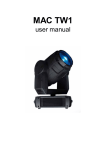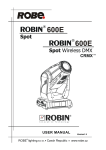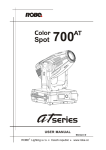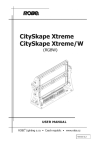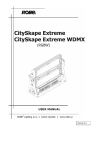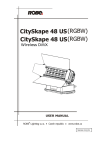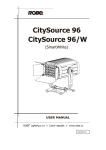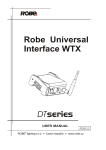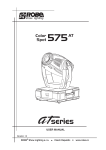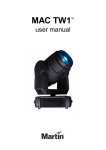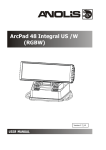Download "user manual"
Transcript
Version1.5
Robin 300 Wash Classic
Table of contents
1. Safety instructions.......................................................................................................... 3
2. Operating determination................................................................................................. 4
3. Fixture exterior view ...................................................................................................... 5
4. Installation....................................................................................................................... 6
4.1 Connection to the mains............................................................................................. 6
4.2 Changing the power supply setting............................................................................. 6
4.3 Installing the lamp....................................................................................................... 7
4.3 Lamp adjustment . ...................................................................................................... 7
4.4 Replacing the colour filters . ....................................................................................... 8
4.5 Rigging the fixture....................................................................................................... 9
4.6 DMX-512 connection................................................................................................. 11
4.7 Stand-alone operation............................................................................................... 12
5. Remotely controllable functions.................................................................................. 13
6. Control menu map......................................................................................................... 14
7. Control menu ................................................................................................................ 16
7.1 Fixture Address......................................................................................................... 16
7.2 Fixture informations................................................................................................... 16
7.3 Personality................................................................................................................ 17
7.4 Lamp On/Off.............................................................................................................. 18
7.5 Manual mode............................................................................................................ 18
7.6 Test sequences......................................................................................................... 19
7.7 Stand-alone setting .................................................................................................. 19
7.8 Reset functions......................................................................................................... 20
7.9 Special functions....................................................................................................... 20
8. Power down mode......................................................................................................... 20
9. RDM................................................................................................................................ 21
10. Error and information messages............................................................................... 22
11. Technical Specifications............................................................................................ 23
12. Maintenance and cleaning.......................................................................................... 25
13. ChangeLog................................................................................................................... 26
CAUTION!
Keep this device away from rain and moisture!
Unplug mains lead before opening the housing!
FOR YOUR OWN SAFETY, PLEASE READ THIS USER MANUAL CAREFULLY
BEFORE YOU INITIAL START - UP!
1. Safety instructions
Every person involved with installation and maintenance of this device have to:
- be qualified
- follow the instructions of this manual
CAUTION!
Be careful with your operations.
With a high voltage you can suffer
a dangerous electric shock when touching the wires!
This device has left our premises in absolutely perfect condition. In order to maintain this condition and to ensure a safe operation, it is absolutely necessary for the user to follow the safety instructions and warning notes
written in this manual.
Important:
The manufacturer will not accept liability for any resulting damages caused by the non-observance of this
manual or any unauthorized modification to the device.
Please consider that damages caused by manual modifications to the device are not subject to warranty.
Never let the power-cord come into contact with other cables! Handle the power cord and all connections with
the mains with particular caution!
Make sure that the available voltage is not higher than stated on the rear panel.
Always plug in the power plug least. Make sure that the power-switch is set to off-position before you connect
the device to the mains. The power plug has to be accessible after installing the device.
Make sure that the power-cord is never crimped or damaged by sharp edges. Check the device and the powercord from time to time.
Always disconnect from the mains, when the device is not in use or before cleaning it. Only handle the powercord by the plug. Never pull out the plug by tugging the power cord.
This device falls under protection class I. Therefore it is essential to connect the yellow/green conductor to
earth.
The electric connection, repairs and servicing must be carried out by a qualified employee.
Do not connect this device to a dimmer pack.
Do not switch the fixture on and off in short intervals as this would reduce the lamp’s life.
During the initial start-up some smoke or smell may arise. This is a normal process and does not necessarily
mean that the device is defective.
Do not touch the device’s housing bare hands during its operation (housing becomes hot)!
For replacement use lamps and fuses of same type and rating only.
CAUTION ! EYE DAMAGES !
Avoid looking directly into the light source
(meant especially for epileptics) !
2. Operating determination
This device is a moving head for creating decorative effects and was designed for indoor use only.
If the device has been exposed to drastic temperature fluctuation (e.g. after transportation), do not switch it on
immediately. The arising condensation water might damage your device. Leave the device switched off until
it has reached room temperature.
Never run the device without lamp!
Do not shake the device. Avoid brute force when installing or operating the device.
Never lift the fixture by holding it at the projector-head, as the mechanics may be damaged. Always hold the
fixture at the transport handles.
When choosing the installation-spot, please make sure that the device is not exposed to extreme heat, moisture
or dust. There should not be any cables lying around. You endanger your own and the safety of others!
The minimum distance between light output and the illuminated surface must be more than 3 meters.
Make sure that the area below the installation place is blocked when rigging, derigging or servicing the fixture.
Always fix the fixture with an appropriate safety rope. Fix the safety rope at the correct holes only.
Only operate the fixture after having checked that the housing is firmly closed and all screws are tightly fastened.
The lamp must never be ignited if the objective-lens or any housing-cover is open, as discharge lamps may
explode and emit a high ultraviolet radiation, which may cause burns.
The maximum ambient temperature 45°C must never be exceeded.
CAUTION!
The lens has to be replaced when it is obviously damaged,
so that its function is impaired, e. g. due to cracks or deep scratches!
Operate the device only after having familiarized with its functions. Do not permit operation by persons not
qualified for operating the device. Most damages are the result of unprofessional operation!
CAUTION!
The lamp has to be replaced when it is damaged
or deformed due to the heat!
Please use the original packaging if the device is to be transported.
Please consider that unauthorized modifications on the device are forbidden due to safety reasons!
If this device will be operated in any way different to the one described in this manual, the product may suffer
damages and the guarantee becomes void. Furthermore, any other operation may lead to dangers like shortcircuit, burns, electric shock, burns due to ultraviolet radiation, lamp explosion, crash etc.
3. Fixture exterior view
1 - Front lens
2 - Tilt lock
3 - Pan lock
4 - Base
5 - Handle
6 - Arm
7 -Moving head
The head should be locked for transportation- the tilt lock latch (2) and the pan lock latch (3) have to be in the
locked positions. To unlock the head, move these latches to unlock positions before operating the fixture.
Rear panel of the base:
1 - 3-pin DMX output
2 - 3-pin DMX input
3 - Fuse holder-neutral
4 - Power switch
5 - Fuse holder-live
6 - Power cord
Front panel of the base:
1 - 4-digit LED display
2 - ESCAPE button
3 - ENTER button
4 - UP button
5 - DOWN button
4. Installation
4.1 Connection to the mains
For protection from electric shock, the fixture must be earthed!
Install a suitable plug on the power cord, note that the cores in the power cord are coloured according to the
following table. The earth has to be connected!
If you have any doubts about proper installation, consult a qualified electrician.
Core (EU)
Core (US)
Connection
Plug Terminal Marking
Brown
Black
Live L
Light blue
White
Neutral
N
Yellow/Green
Green
Earth
Verify the power supply settings before applying power!
If you wish to change the power supply settings, see the chapter below.
4.2 Changing the power supply setting
Both the transformer and the ballast must be connected correctly for the local AC voltage and frequency.
The wrong settings can cause poor performance or demage of the moving head. The factory settings are printed
next to the power switch.
If you want to change the power supply settings, follow the instructions:
1. Disconnect the fixture from AC power.
2. Remove the top base cover (closest to the power cord) by loosening the 9 screws.
3. Move the wire 1 on the transformer connection block to the position according to the desired voltage.
4. Move the wires 2 and 3 on the ballast connection block to the position according to the desired voltage
(frequency).
5. Close the base before applying AC power.
4.3 Installing the lamp
DANGER ! Install the lamp with the device switched off only.
Unplug from mains before !
To insert the new lamp.
1. Disconnect the fixture from power and allow it to cool at least 15 minutes.
2. Make sure that the fixture´s head is in the position as
shown on the picture (notices on the lamp cover are in
readable position) .Loosen the two quarter-turn
fasteners (1) marked “X,Y“ on the lamp cover to
open this cover.
3. Holding the lamp by its ceramic base, carefully
turn the lamp to the left to loosen the lamp from
the lamp holder.
Gently pull the lamp out of the lamp holder
4. Holding the new lamp by its ceramics base, gently
insert the lamp to the lamp socket and turn the base
to the right. Make sure that the lamp is installed tightly
into the lamp socket.
Do not install a lamp with a higher wattage! A lamp
like this generates temperatures the device is not
designed for. Damages caused by non-observance are not subject to warranty. Please follow the lamp
manufacturer‘s
notes! Do not touch the glass bulb bare hand during the
installation!
5. Re-insert the lamp cover and tighten the two quarter-turn
fasteners (1).
6. Switch on the fixture.
7. Align the lamp (see instructions below)
8. Reset the "LA.ti.” and "LA.St” counters
in the menu "InFo”.
Do not operate this fixture with open lamp cover!
4.3 Lamp adjustment
The lamp holder is aligned at the factory. Due to differences between lamps,the fine adjustment may improve
light performance:
To adjust the lamp in the fixture.
1. Switch on the fixture and after its reset turn on the
lamp.
2. Go to the "SPEC." menu and select the item "LA.Ad." to
project the light beam on the wall.
3. Use items in this menu to focus the light beam on the
wall .
3. Turn adjustment screws marked “A, B, C” (2) one after
another until you reach a max. light output.
4. Center the hot-spot (the brightest part of the beam) using
these 3 adjustment screws.
4.4 Replacing the colour filters
DANGER!
Install the colour filters with the device switched off only.
Unplug from mains before!
Colour filters
1. Disconnect the fixture from mains and allow it to cool.
2. Remove the top plastic cover of the head by loosening the 4 quarter-turn fasteners on the cover.
3. Turn the colour wheel to the desired position.The dichroic filters are fixed on the colour wheel by the
magnets.
4. Release the dichroic filter from the colour wheel by inclining it from its position
to break the power of the magnet. Protect the glass filter with a piece of paper or clout.
5. Insert a new dichroic filter into the colour wheel.
6. Place the top cover back before applying power.
4.5 Rigging the fixture
The installation of the fixture has to be built and constructed in a way that it can hold 10 times the weight for 1
hour without any harming deformation.
The installation must always be secured with a secondary safety attachment, e.g. an appropriate catch net.
This secondary safety attachment must be constructed in a way that no part of the installation can fall down if
the main attachment fails.
When rigging, derigging or servicing the fixture staying in the area below the installation place, on bridges,
under high working places and other endangered areas is forbidden.
The operator has to make sure that safety-relating and machine-technical installations are approved by an expert
before taking into operation for the first time and after changes before taking into operation another time.
The operator has to make sure that safety-relating and machine-technical installations are approved by an
expert after every four year in the course of an acceptance test.
The operator has to make sure that safety-relating and machine-technical installations are approved by a skilled
person once a year.
The projector should be installed outside areas where persons may walk by or be seated.
IMPORTANT! OVERHEAD RIGGING REQUIRES EXTENSIVE EXPERIENCE, including (but not limited to)
calculating working load limits, installation material being used, and periodic safety inspection of all installation
material and the fixture. If you lack these qualifications, do not attempt the installation yourself, but instead use
a professional structural rigger. Improper installation can result in bodily injury or damage to property.
The fixture has to be installed out of the reach of people.
If the fixture shall be lowered from the ceiling or high joists, professional trussing systems have to be used. The
fixture must never be fixed swinging freely in the room.
Caution: Fixtures may cause severe injuries when crashing down! If you have doubts concerning the safety of
a possible installation, do not install the moving head!
Before rigging make sure that the installation area can hold a minimum point load of 10 times the fixture’s
weight.
.
Danger of fire !
When installing the device, make sure there is no highly inflammable
material (decoration articles, etc.) in a distance of min. 1 m.
CAUTION!
Use 2 appropriate clamps to rig the fixture on the truss.
Follow the instructions mentioned at the bottom of the base.
Make sure that the device is fixed properly! Ensure that the
structure (truss) to which you are attaching the fixtures is secure.
The fixture can be placed directly on the stage floor or rigged in any orientation on a truss without altering its
operation characteristics .
For securing a fixture to the truss install a safety wire that can hold at least 10 times the weight of the fixture.
Use only safety wire with screw-on carabine. Pull the safety wire through the carrying handles and around the
truss as shown on the pictures below.
Note: If the safety wire is too long, whip it several times around the trusss in order to attach the fixture tight.
In case of an accident, the way of the falling fixture will be short.
Truss installation
1.Bolt each clamp (1) to the omega holder (3) with M12 bolt and lock nut through the hole in the holder.
2.Fasten the omega holders on the bottom of the base by inserting both quick-lock fasteners (4) into the holes
of the base and tighten fully clockwise.
3. Pull the safety wire (2) through the carrying handles (5) and around the truss (6) as shown on the pictures
below.
Securing the fixture via one safety wire Securing the fixture via two safety wires
1-Clamps
2-Safety wire
3-Omega holder
4-Quick-lock fastener
5-Carrying handles
6-Truss
When installing fixtures side-by-side,
avoid illuminating one fixture with another!
DANGER TO LIFE!
Before taking into operation for the first time,the installation has to be approved by
an expert!
10
4.6 DMX-512 connection
The fixture is equipped with 3-pin XLR sockets for DMX input and output.The sockets are wired in parallel.
Only use a shielded twisted-pair cable designed for RS-485 and 3-pin XLR-plugs and connectors in order to
connect the controller with the fixture or one fixture with another.
DMX - output
XLR mounting-sockets (rear view):
DMX-input
XLR mounting-plugs (rear view):
1 - Shield
2 - Signal (-)
3 - Signal (+)
1 - Shield
2 - Signal (-)
3 - Signal (+)
If you are using the standard DMX controllers, you can connect the DMX output of the controller directly with
the DMX input of the first fixture in the DMX chain. If you wish to connect DMX controllers with other XLR-outputs, you need to use adapter cables.
Building a serial DMX-chain:
Connect the DMX-output of the first fixture in the DMX-chain with the DMX-input of the next fixture. Always
connect one output with the input of the next fixture until all fixtures are connected.
Caution: At the last fixture, the DMX-cable has to be terminated with a terminator. Solder a 120 Ω resistor
between Signal (–) and Signal (+) into a 3-pin XLR-plug and plug it in the DMX-output of the last fixture.
Building a master/slave-chain:
Connect the DMX-output of the master fixture in the data-chain with the DMX-input of the first slave. Always
connect output with the input of the next slave until all slaves are connected (up to 9 fixtures).
Caution: It’s necessary to insert the XLR termination plug (with 120 Ohm) into the input of the master fixture
and into the output of the last slave fixture in the link in order to ensure proper transmission on the data link.
11
4.7 Stand-alone operation
The fixtures on a data link are not connected to the controller but can execute pre-set programs which can be
different for every fixture. To set the program to be played,see the „Stand-alone setting” (menu „St.AL.”).
„Stand-alone operation” can be applied to the single fixture (the fixture may be set to the master/slave mode)
or to multiple fixtures operating synchronously.
Synchronous operation of multiple fixtures requires that they must be connected on a data link and one of them
is set as a master (master mode) and the rest as the slaves (slave mode). To set the fixture as the master or
slave, see the „Fixture address” (menu „A001”).
If the master fixture runs a reset, switches On/Off the lamp or plays test (program), all slaves will execute these
acts too (e.g. if the master fixture has switched the lamp off, no slaves can switch the lamp on)
The master fixture starts simultaneous program start in the other slave fixtures. All fixtures have a definite,
synchronized starting point when playing back their programs. The number of running program is the same
in all slaves and depends on the master’s choice (menu „St.AL.”). Every fixture runs its program repeatedly,
starting the program step No. 1 when requested by the master.
For example:
If the slave fixture has a shorter program length, it will continously repeat its program until the master fixture
finishes its own program and restarts its program running (slave 1- prog. step 3 will not be finished).
If the slave fixture has a longer program length, it will restart at prog. step 1 before it completes all its prog.
steps
(slave 2 - prog. step 5 will not be played)- see the picture bellow.
Note: Disconect the fixtures from the DMX controller before master/slave operating, otherwise data collisions
can occur and the fixtures will not work properly!
It’s necessary to insert the XLR termination plug (with 120 Ohm) into the input of the master fixture and into the
output of the last slave fixture in the data link in order to ensure proper transmission on the data link.
From the master’s control panel is possible to control any slave in a master/slave chain.
12
5. Remotely controllable functions
Lamp
The Robin 300 Wash Classic is to be operated with a Philips MSR Gold 300/2 MiniFastFit .
Note: It is also important to note, that the discharge lamp is cold restrike types, that means, that they have
to be cold before re-striking. For this reason, you have to wait 5 minutes after having switched the lamp off
before you can switch it on again. If you try to switch on the lamp within 5 minutes after having switched it off,
the Robin 300 Wash Classic will store this information and automatically ignite the lamp when the 5 minutes
period has expired.
Colour wheel
This wheel contains 7 replaceable 'SLOT&LOCK' dichroic filters + open.The colour wheel can be positioned
between two adjacent colours in any position. It is also possible to rotate the colour wheel continuously at different speeds ("Rainbow effect“ in both directions).
CMY colour mixing system
The CMY color mixing system is based on graduated cyan, magenta, and yellow colour filters. A continuous
range of colors may be achieved by varying the amount of each filter from 0 to 100%.
tates in both directions at different speeds, 16 prism/gobo macros are available.
Zoom
Motorized zoom unit enables zoom between 10° and 35° beam angle.
Dimmer/Shutter unit
Smooth 0 - 100 % dimming is provided by the mechanical dimmer /shutter unit. This unit is also used for strobe
effects with variable speed.
13
6. Control menu map
Default settings=Bold print
Level 1
Level 2
Level 3
A001
dM.Ad.
001-512
MA.SL.
d.AbL
Level 4
MASt.
SLA
InFo
Po.ti.
totl
rSEt
La.ti.
totl
rSEt
LA.St.
totl
rSEt
FiLt.
AL.PE.
10-300
EL.tI.
DM.In.
Pan
0-255
:
tEMP.
F.Dim
0-255
Cur.t.
boAr.
rSEt
HEAd
Hi.tE.
VErS
IC1
IC2
IC3
IC4
PErS.
r.PAn.
On, Off
r.tilt
On, Off
dM.Pr.
Mod1
Mode 2
Mode 3
LA.Pr.
dISP.
bL.Co.
LA.Au.
On, Off
d.L.OF.
On, Off
d.M. On
On, Off
d.M.OF
On, Off
LA.dE
0-90
d.On
Off, On
d.Int.
20...100
turn
Off, On
Off, On
FEEd.
Off, On
Mi.SE.
1-10-20
FAn.S.
Auto, High
P.t.Mo.
ti.Mo., SP. Mo.
A.bLc
P.t. M.
On, Off
CoL.M.
On, Off
tEM.U.
°C, °F
In.Po.
PAn
:
F.dim
Stor
dF.SE.
14
Level 5
Level 6
Level 1
Level 2
LAMP
Off, On
MAn.M.
PrE.C.
Level 3
Level 4
PAn
PAn1...PAn
Level 5
:
dimr
Man.C.
dim1...dim5
PAn
:
F.dim
tESt
Mod.1
Pan
0-255
tilt
0-255
Zoom
0-255
Mod.2
St.AL.
Audi
On, Off
Auto
Off
tESt
ProG.
PLAY
tESt
Edit
St.01
PAn
:
:
St.50
S.tim.
ProG
0-255
0-25.5
COPY
RESE
SPEC
LA.Ad.
PAn
:
tILt
Zoom
rdML
rdMH
Adj.
DMH
PAn
0-255
:
CAL.u.
F.dinr
0-255
PAn
0-255
:
0-255
Stor.
UPd.
15
Level 6
7. Control menu
The control panel situated on the front panel of the base offers several features. You can simply set the DMX
address, read the number of the lamp or unit hours, switch On and Off the lamp, run test, make a reset and
also use many functions for setting fixture behaviour.
Control elements on the control board:
[MODE] button-leaves menu without saving changes.
[ENTER] button- enters menu, confirms adjusted values and leaves menu.
[UP] button and [DOWN] button- moves between menu items on the the same level, sets values.
After switching the fixture on, the display shows the initial screen:
Use [UP], [DOWN] to browse through the menu. To select a function or submenu, press [ENTER].
7.1 Fixture Address
Use this menu to set the DMX address of the fixture or set the fixture as a Master (Slave).
dM.Ad. - DMX addressing. Select this submenu to set DMX start address.
MA.SL. - Master/slave addressing. Select this submenu to set the fixture as a Master or Slave.
Option „d.AbL” deactivates master/slave setting.
7.2 Fixture informations
Use this menu to read an useful information about the fixture.
Po.ti. - Power on time. Select this submenu to read the number of operation hours.
totL - The function shows the total number of the operation hours since the Robin 300 Wash Classic has
been fabricated.
rSEt - The function shows the number of the operation hours that the Robin 300 Wash Classic has been
powered on since the counter was last reset. In order to reset this counter to 0 you have to hold [UP]
and [DOWN] and press the [ENTER].
La.ti. - Lamp on time. Select this submenu to read the number of the operation hours with the lamp on.
totL - The function shows the total number of the operation hours with the lamp on since the Robin 300
Wash Classic has been fabricated.
rSEt - The function shows the number of the operation hours with the lamp on that the Robin 300 Wash
Classic has been powered on since the counter was last reset. In order to reset this counter to 0 you
have to hold [UP] and [DOWN] and press the [ENTER].
LA.St. - Lamp strikes. Select this submenu to read the total number of the lamp strikes.
totL - The function shows the total number of the lamp strikes since the Robin 300 Wash Classic has
been fabricated.
rSEt - The function shows the number of the lamp strikes since the counter was last reset. In order to
reset this counter to 0 you have to hold [UP] and [DOWN ] and press the [ENTER].
FiLt - Filters. Regular cleaning of the air filters is very important for the fixture´s life and performance.
Cumulation of dust, dirt and fog fluid residues reduces the fixture´s light output and cooling ability.
The two items of this menu help you to keep cleaning period of the air filters.
AL.PE. - Set alert period - cleaning schedule for the fixture depends on the operating environment.
It is therefore impossible to specify accurate cleaning interval. This function allows
you to change the cleaning interval of the air filters. This “alert“ value is 300 hours and it
is set as default. Inspect the fixture within its 300 hours of operation to see whether cleaning
is necessary. If cleaning is required, clean all air filters and change the value in this menu
on acceptable level. Min. level of alert period is 10 hours, max. is 300 hours.
EL.ti. - Elapsed time - the option allows you to read the time which remains to cleaning air filters.
The time period is set in the menu mentioned above.
Expired time period is signalized by the message ”FiLt” on display.
Clean the filters and reset this menu item (press and hold the [UP] and [DOWN ]
buttons and at the same time press the [ENTER] ).
16
tEMP - Fixture temperatures. Select this submenu to read the fixture temperatures (°C). Please note that
the outside temperature should not exceed 45° C.
Cur.t. - Current fixture temperatures.
boAr. - Current temperature in the fixture base
HEAd - Current temperature of the head inside.
Hi.tE. - Maximum fixture temperatures.
boAr. - The function shows the max. temperature in the fixture base since the Robin 300 Wash
Classic has been fabricated.
HEAd - The function shows the max.temperature of the head inside since the Robin 300 Wash
Classic has been fabricated.
rSEt - Maximum resetable temperatures.
boAr. - The function shows the maximum temperature in the fixture base since the counter was
last reset. In order to reset the counter to 0 you have to hold [UP] and [DOWN] and press the
[ENTER].
HEAd - The function shows the maximum temperature of the head inside since the counter was
last reset. In order to reset the counter to 0 you have to hold [UP] and [DOWN] and press the
[ENTER].
DM.In. - Readout of DMX values. Select this function to read DMX values (0-255) of each channel received by
the fixture.
PAn
a coarse pan movement
Zoom a zoom
F.PAn
a fine pan movement
F. Zon.a fine zoom
tilt
a coarse tilt movement
Stro. a shutter,strobe
F.tilt
a fine tilt movement
dinr a dimmer
Spd
a pan/tilt speed
F.din. a fine dimmer
Func.
a special function
Colo
a colour wheel F.CoL.
a fine colour wheel
CYAn
a cyan flag
MAGE.
a magenta flag
YELL.
a yellow flag MACr.
a CMY macros
C.SPd.
a speed of CMY flags
VErS.
- Software version. Select this function to read the software version of processors:
IC1 - Pan/tilt processor
IC2 - EEProm
IC3. - Strobe/zoom processor
IC4. - Colour wheel/CMY processor
7.3 Personality
Use this menu to to modify Robin 300 Wash Classic operating behavior.
r.PAn - Pan reverse.Select this function to invert the pan movement.
r.tilt - Tilt reverse. Select this function to invert the tilt movement.
DM.Pr. - DMX preseting. Select this function to set desired channels setting. Please refer to the„DMX protocol”
for detail description.
LA.Pr. - Lamp presetting. Select this menu to change the lamp „behaviour”.
LA.Au. - Select this function to turn the lamp on automatically after switching the fixture on.
d.L.OF. - Select this function to switch off the lamp via DMX. dM.On - This function allows you to strike the lamp automatically after 26 seconds if DMX signal is
present on the data link. If the ignition is unsuccessfull (e.g.lamp is too hot), the fixture will try to ignite
the lamp after next 26 s.This process will repeat until the lamp lights.
dM.OF. - This function allows you to switch Off the lamp automatically after 2 minutes if DMX signal
is missing on the data link.
LA.dE. - Lamp ignition delay. This function allows you to set the time delay (0-90s) before the lamp
will be ignited. This setting will not affect starting the lamp directtly from the control panel (menu „Lamp
On/Off”).
17
LA.Sn. - Switching on/off the lamp light sensor. Select this function to switch the lamp light sensor on
or off. The option „On” is for standard operation.
DiSP. - Display adjusting. This function allows you to change the display settings.
turn - Select this function to turn the display by 180°.
d.On - This function allows you to keep the display on or to turn off automatically 2 minutes after last
pressing any button on the control panel.
d.Int. - Select this function to adjust the display intensity (20-min.,100-max.).
A.bLc. - Automatic blackout. Use this function if you wish to close the light output during effect changes.
P.t.M. - This function closes the light output during pan/tilt changes.
Col.M. - This function closes the light output during colour wheel moving.
bL.Co. - Blackout during movement correction. Select this function to enable the blackout during the
head movement correction (if the moving head lost its correct pan/tilt position for a short moment).
FEEd - Pan/Tilt feedback.This function allows to return the mowing head to the required pan/tilt position
after changing the position by external force (e.g.by stroke).
Be careful, the Pan/Tilt Feedback OFF is not suitable for standard operation and the head of the fixture
can be demaged!
Mi.SE. - Microphone sensitivity. Select this function to adjust the microphone sensitivity from 1 (maximum)
to 20 (minimum). If the sensitivity is correctly adjusted, the upper segment of the first digit blinks in the bass
beats.
Fan.S. - Fan speed operating modes. By using this function you can choose 2 types of the fan speed operating
modes.
Auto - The fans automatically raise their speed in order to control inside temperature of the head, if the
temperature inside increases about certain level (the low fan speed reduces the cooling of the lighting).
This cycle can repeat several times until the temperature inside is on a suitable level.
HIGH - The cooling fans work on max. speed (max. cooling). This mode we recommend for high ambient
temperature (35°C and more).
P.t.Mo. - Pan/tilt movement mode. Use this menu to set the character of the pan/tilt movement.
ti.Mo. - Time mode. Pan and tilt will move with different speeds and they will come at the same time
to end point (pan and tilt sets its optimal speed).
SP.Mo. - Speed mode. Pan and tilt will move with the same speed as adjusted by the channel 5 (Pan/Tilt
speed). E.g. pan will come to the end point and wait for tilt, which has longer track.
In.Po. - Init effect positions. Select this function to adjust all effects to the desired initial positions. After switching the fixture on (if DMX is not connected),all effects will move to initial positions. Use the [UP] and [DOWN]
buttons to select desired channel and press [ENTER]. Set the effect to the desired position using [UP] and
[DOWN] buttons and confirm by pressing [ENTER]. After having adjusted all effects, select „Stor.” to save all
initial values to the memory.
dF.SE. - Default Settings. Select this option to reset all fixture personalities to the default values.
7.4 Lamp On/Off
Use this option in order to switch on/off the lamp.It is also important to note, that the lamp is cold restrike type,
that means, that it has to be cold before striking. 7.5 Manual mode
Select this menu to call up presetted positions of channel effects or direct control channel effects.
PrE.C. - Presetted effect control. Select this menu to call up presetted positions of the channel effects.
Man.C. - Manual effect control. Select this menu to control effects by the control buttoms on
the control board.
18
7.6 Test sequences
Use this menu to to run a special demo-test sequences without an external controller, which will show you some
possibilities of using Robin 300 Wash Classic.
Mod. 1 - Mode 1. This mode is suitable for projections on the wall, ceiling or ground without any head movement.
Mod. 2 - Mode 2. This mode uses all Robin 300 Wash Classic functions including pan/tilt movement and
therefore is good for a complete introduction of the fixture.
7.7 Stand-alone setting
Use this menu to set options for stand-alone mode as a presetting of playing program,programming and
modifying program.
Audi - Music trigger. Select this function to enable the sound control of the running program via the built-in
microphone.
Auto - Presetting playback. This function allows you to select the program which will be played in the standalone mode after switching the fixture on. Selected program will be played continuously in a loop.
d.Abl - The option disables „Auto” function.
tESt - The option will start built-in test program.
ProG - The option will start user- created program
PLAY - Playing program. Select this menu to run a user-created pgram in a loop.
tESt - The option starts built-in test program.
ProG - The option starts user -created program
Select the program you wish and press [ENTER]. The selected program starts running. By Pressing [ENTER]
again is possible to pause the program running.
Edit - Editing program. Select this menu to edit or create the program. The Robin 300 Wash Classic has one
built-in program and one user-editable program up to 50 steps. Each program step has a step time. Step time
- the time, during which effects last in the current step.
To edit program:
Procedure:
1. Press [UP] or [DOWN] to select the menu "Edit" and press [ENTER].
2. Press [UP] or [DOWN] to select the desired program step and press [ENTER]-button.
3. Press [UP] or [DOWN] to select the desired item and press [ENTER]-button. Now you can edit by [UP] or
[DOWN] buttons the DMX value (0-255) for selected item:
P.End. a total number of the program steps (value 1-50).
This value you should be set before starting of programming (e.g. if you want to create
program with the 10 steps, set P.End=10).
PAn
a coarse pan movement
Zoon a zoom
F.PAn
a fine pan movement
F. Zon.a fine zoom
tilt
a coarse tilt movement
Stro. a shutter,strobe
F.tilt
a fine tilt movement
dinr a dimmer
Spd
a pan/tilt speed
F.din. a fine dimmer
Func.
a special function
Colo
a colour wheel F.Col.
a fine colour wheel
CYAn
a colour macros
MAGE.
a effect speed
YELL.
a colour -gobo wheel MACr.
a fine colour -gobo wheel
C.SPd.
a rotating gobo wheel
S.tim. a step time, value 0,1-25.5 seconds
COPY a copying the current prog. step to the next prog. step. If the last prog. step is copied to the
next prog. step, parameter „P.End” is increased about one auttomatically(except step 50).
4. Press [ENTER]-button to confirm adjusted value .
5. Press [MODE]-button, select next prog. step and repeat this procedure (steps 3 - 5).
19
7.8 Reset functions
This option enables the Robin 300 Wash Classic to index all effects and return to their standard positions.
7.9 Special functions
Use this menu for special services like adjusting lamp or adjusting effects.
LA.Ad. - Lamp adjustment. This function can be used when you make the fine adjustment of the lamp. If you
select this function, all effects will be canceled, shutter will be opened and the dimmer intensity will be set at
100%.By using the options „PAn, tilt, Zoom” you can aim the light on a flat surface (wall) and perform the
fine lamp adjustment.
rdML --- Code.This menu item shows the first part of the RDM identification code.
rdMH --- Code.This menu item shows the second part of the RDM identification code.
AdJ. - Effect adjustment. By this menu you can calibrate and adjust the effects to their standard/right positions.
dMH - Use the menu to set all effects to desired posiotions.
CAL.u - Use the menu to perform fine calibration of effects.
1. Calibration via the control board
Disconnect DMX controller from the fixture. Press [ENTER] and use [UP] and [DOWN] in order to display the
following items: "PAn, tiLt, Colo., CYAn, MAGE., YELL., din1, din2, Stor.” for very smooth function calibration.
Select one of them, press [ENTER] and use the [UP] and [DOWN] in order to adjust their right value from 0
to 255. Then press [ENTER] to confirm or [MODE] to cancel and return to the menu. This can be repeated for
each calibration parameter if it is required. When the calibration is finished, it is necessary to use the „Stor”
item in order to write the calibration values to the memory (EPROM) and to make a reset in order to check the
newly adjusted positions of the calibrated effects.
2. Calibration via the external controller
Connect the DMX controller to the fixture, press [ENTER] and the [UP] and [DOWN] buttons in order to display the following items: " PAn, tiLt, Colo., CYAn, MAGE., YELL., din1, din2, Stor.”. Select one of them and
press [ENTER].
Now you can calibrate this effect by your controller. The DMX calibration protocol is described in the table
mentioned below.
DMX calibration protocols:
Effect
"Pan”- pan movement
„tiLt”- tilt movement
„Colo.”-colour wheel
„CYAn.”- cyan flag
„MAGE.” - magenta flag
„YELL.” - yellow flag
„din1”- Dimmer lamella 1
„din2”- Dimmer lamella 2
Mode 1
channel 19
channel 20
channel 21
channel 22
channel 23
channel 24 channel 25
channel 26
Mode 2
channel 16
channel 17
channel 18
channel 19
channel 20
channel 21
channel 22
channel 23
Mode 3 channel 14
channel 15
channel 16
channel 17
channel 18
channel 19
channel 20
channel 21
After having calibrated required effects, use the "Stor.” item in order to write the calibration values to the
memory (EEPROM) and to make a reset of the fixture.
uPd - Updating mode. The menu item allows you to update software in the fixture via either serial or USB port
of PC.
The following are required in order to update software:
- PC running Windows 95/98/2000/XP or Linux
- DMX Software Uploader
- Flash cable RS232/DMX No.13050624 (if you want to use a serial port of PC)
- Robe Universal Interface (if you want to use an USB port of PC)
Note1: Software update should execute a qualified person. If you lack qualification, do not attempt the update
yourself and ask for help your ROBE distributor.
20
Note 2: DMX address, programs and all items in the menu "PErS" will be set to their default values.
To update software in the fixture:
I. Installation of the DMX Software Uploader.
1. DMX Software Uploader program is available from the ROBE web site at WWW.robe.cz.
2. Make a new directory ( e.g. Robe_Uploader) on your hard disk and download the software to it.
3. Unpack the program from the archive.
II.Fixture software updating.
1.
Determine which of your ports is available on your PC and connect it:
-
with the DMX input of the fixture if you using the flash cable RS232/DMX
-
with the DMX input of the Robe Universal Interface if you using the USB cable.
Disconnect the fixture from the other fixtures in a DMX chain. Turn both the computer and the fixture on. Make
sure the lamp is switched off (only if the fixture involves a lamp).
2.
Switch the fixture to the updating mode:
1
Use the UP/DOWN buttons to find “SPEC.“ menu.
2
Press the ENTER button.
3
Use the UP/DOWN buttons to select “ uPd.“ item.
4
Press the ENTER button
5
Use the UP/DOWN buttons to select “ yES“ option
6
Press the ENTER button
Note: If you do not want to continue in software update, you have to switch off and on the fixture
to escape from this menu.
3. We recommend to cancel all running programs before start the Software Uploader.
4. Run the Software Uploader program. Select desired COM and then click on the Connect button.
If the connection is OK, click on the Start Uploading button to start uploading. It will take several minutes
to perform software update. If the option "Incremental Update" is not checked, all processors will be
updated (including processors with the same software version).
If you wish to update only later versions of processors, check the Incremental Update box.
Avoid interrupting the process. Update status is being displayed in the Info Box window.
When the update is finished, the line with the text “The fixture is successfully updated‘will appear in
this window and the fixture will reset with the new software.
8. Power down mode
This mode omits fixture reset after switching the fixture on and lowers motor powers of the fixture. „Power down
mode” is useful in special cases e.g. if the fixture is in a flight case and you want to set its DMX address without
taking it out from the case. To enter „Power down mode”, press and hold [UP] and [DOWN] and at the same
time switch on the Power switch. The following message appears on the display: "P.d.Mo.”
Now you can set features and behaviour of the fixture by using the control panel on fixture base.
If you want to go escape from this mode, run a fixture reset.
Note: All motors (except pan and tilt motors) in the „Power down mode” are deactivated and switching on the
fixture lamp from the control panel is blocked.
9. RDM
This fixture is ready for RDM operation.RDM (Remote Device Management) is a bi-directional communications
protocol for use in DMX512 control systems, it is the new open standard for DMX512 device configuration and
status monitoring.
The RDM protocol allows data packets to be inserted into a DMX512 data stream without adversely affecting
existing non-RDM equipment. By using a special „Start Code,“ and by complying with the timing specifications
for DMX512, the RDM protocol allows a console or dedicated RDM controller to send commands to and receive
messages from specific moving lights.
RDM allows explicit commands to be sent to a device and responses to be received from it.
The list of commands for Robin 300 Wash Classic is the following.
Parameter ID
Discovery command SET command
DISC_UNIQUE_BRANCH
*
DISC_MUTE
*
DISC_UN_MUTE
*
21
GET command
DEVICE_INFO
*
SUPPORTED_PARAMETERS
*
SOFTWARE_VERSION_LABEL
*
DMX_START_ADDRESS
*
*
IDENTIFY_DEVICE
*
*
DEVICE_MODEL_DESCRIPTION
*
MANUFACTURER_LABEL
*
*
DEVICE_LABEL
*
SENSOR_DEFINITION
*
SENSOR_VALUE
*
DISPLAY_INVERT
*
*
DISPLAY_LEVEL
*
*
PAN_INVERT
*
*
TILT_INVERT
*
*
DEVICE_RESET
*
DMX_PERSONALITY
*
*
DMX_PERSONALITY_DESCRIPTION
*
STATUS_MESSAGES
*
STATUS_ID_DESCRIPTION
*
LAMP_STATE
LAMP_ON_MODE
DEVICE_HOURS
LAMP_HOURS
1
*
*
*
*
*
2
*
2
LAMP_STRIKES
*
2
...Another options for this command (only for Robe´s fixtures):
value PARAMETER_DATA=0x84 - lamp OFF by DMX value on DMX channel
value PARAMETER_DATA=0x88 - lamp OFF if DMX is not present
2
...Commands relative resetable values
1
10. Error and information messages
L.On.
This message appears if you try to switch on the lamp within 5 minutes after having switched it off (the lamp
is too hot). The message will appear on the display if the lamp doesn’t ignite within 20 seconds. The Robin
300 Wash Classic will store this information and automatically ignite the lamp when the 5 minutes period has
expired.
Caution: The message is disabled if the lamp light sensor (function „En.Sn.”) is switched Off
LA.Er.
The ignition of the lamp was seven times unsuccessful and the display shows „LA.Er, meaning that the lamp
could be damaged or even missed or there could be a failure on the ignitor or ballast. Please place or replace
the lamp, check the ambient temperature or contact your dealer if the situation was not caused by the lamp.
Caution: The message is disabled if the lamp light sensor (function „En.Sn.”) is switched Off.
Co.Er. (color wheel error)
This messsage will appear after the reset of the fixture if the magnetic-indexing circuit malfunctions (sensor
failed or magnet missing) or the stepping motor is defective (or its driver circuit on the main PCB). The color
wheel is not located in the default position after the reset.
MG.Er. (magenta error)
The message will appear after the reset of the fixture if the magnetic-indexing circuit malfunctions (sensor failed
or magnet missing) or the stepping motor is defective (or its driver circuit on the main PCB). The magenta flag
is not located in the default position after the reset.
22
CY.Er. (cyan error)
The message will appear after the reset of the fixture if the magnetic-indexing circuit malfunctions (sensor failed
or magnet missing) or the stepping motor is defective (or its driver circuit on the main PCB). The cyan flag is
not located in the default position after the reset.
YE.Er. (yellow error)
The message will appear after the reset of the fixture if the magnetic-indexing circuit malfunctions (sensor failed
or magnet missing) or the stepping motor is defective (or its driver circuit on the main PCB). The yellow flag is
not located in the default position after the reset.
Ft.Er.
This error message informs you that the fixture was overheating (occured if the ambient temperature is 45° C
or more) and that the temperature sensor switched off the lamp.
Fr.Er.
This message will appear if the frequency of the main is not standard 50 or 60 Hz. This message can appear as
a result of the interference during the lamp starting (if the lamp or igniter is old) or as a result of the interference
by neighbouring devices. In these cases the message does not affect the fixture operating!
Sn.Er.
This message appears if the lamp lighting sensor is failed.
PoEr
This message will appear if the fixture was shortly disconnect from the main.
PA.Er. (Pan-yoke movement error)
This message will appear after the reset of the fixture if the yoke.s magnetic-indexing circuits malfunction
(sensors failed or magnet missing) or the stepping motor is defective. (Or its driving IC on the main PCB). The
yoke is not located in the default position after the reset.
ti.Er. (TILT-head movement error)
This message will appear after the reset of the fixture if the head.s magnetic-indexing circuit malfunctions
(sensor failed or magnet missing) or the stepping motor is defective. (Or its driving IC on the main PCB). The
head is not located in the default position after the reset.
MA.Er. (Master error)
The message informs you that the fixture was addressed as a master and DMX signal is connected to its input.
Disconnect the DMX controller from fixture’s input and address the fixture as the master again.
t.M.Er. (Temperature measuring error)
The message informs you that the communication betwen the head and the main board was cut off (or the head
temperature sensor is defective) and the lamp was switched off.
11. Technical Specifications
Electrical:
Input voltage:.......................... 208/230/240V, 50/60Hz
Live Fuse:...............................T 4 A@230V
Neutral Fuse:..........................T 4 A@230V
Power consumption:................450VA
Lamp:
Approved models: Philips: : MSR Gold 300/2 MiniFastFit
MSD Gold 300/2 MiniFastFit
Base:PGJX 28
Osram: HSD 300W80/P28 Lok-it
Base:PGJX 28
Ballast:
Magnetic
23
Optical System:
High luminous-efficiency glass reflector
zoom range: 10°-35°
Colour wheel:
7 replaceable 'SLOT&LOCK' dichroic filters (including UV filter)
CMY + CTO mixing module
Smooth CMY colour mixing system
30 colour macros
Zoom:
Strobe:
Motorized zoom
Strobe effect with variable speed (max.15 flashes/sec.)
Random strobe effect
Dimmer:
Smooth dimmer from 0 - 100 %
Electronics:
4-digit LED display for fixture setting and addressing
Readout fixture and lamp usage, receiving DMX values, temperatures, etc
Built-in analyzer for easy fault finding, error messages
Remotely switching on/off the lamp
Built-in demo sequences
Black-out while head moving, colour or gobo changing
Silent fans cooling,
Self-resetable thermo-fuse
Stand-alone operation
One user editable program up to 50 steps
Supported protocols: USITT DMX 512,RDM
Support of RDM (Remote Device Management)
3 DMX modes (18, 15, 13 control channels)
Pan/Tilt
Pan movement range 540°
Tilt movement range 280°
16 bit movement resolution
Automatic Pan/Tilt position correction
Remotely controllable speed of pan/tilt movement for easy programming
Movement control: tracking and vector
Pan/tilt-lock mechanism
Rigging
Mounting points: 2 pairs of 1/4-turn locks
Mounting horizontally or vertically via 2 Omega brackets
Temperatures
Maximum ambient temperature : 45° C
Maximum housing temperature : 80° C
Minimum distances
Min. distance from flammable surfaces: 1 m
Min. distance to lighted object: 2 m
Total heat dissipation
1501 BTU/h (calculated)
24
Weight (net):
22.6 kg
Dimensions (mm)
Accessories
- Omega holder (No.99010420)................................2 pcs
Optional Accessories
- Flash cable RS232/DMX (No.13050624)
- Module of Front wide-angle lens D200 (No.99011101)
- Top hat standard 45 (No.10980044)
- Top hat long 70 (No.10980045)
- Top hat 3-ring 45 (No.10980046)
- Top hat 3-ring 70 (No.10980050)
25
12. Maintenance and cleaning
It is absolutely essential that the fixture is kept clean and that dust, dirt and smoke-fluid residues must not build
up on or within the fixture. Otherwise, the fixture‘s light-output will be significantly reduced. Regular cleaning will
not only ensure the maximum light-output, but will also allow the fixture to function reliably throughout its life.
A soft lint-free cloth moistened with any good glass cleaning fluid is recommended, under no circumstances
should alcohol or solvents be used!
DANGER !
Disconnect from the mains before starting any
maintenance work
The front objective lens will require weekly cleaning as smoke-fluid tends to building up residues, reducing
the light-output very quickly. The cooling-fans should be cleaned monthly.
The interior of the fixture should be cleaned at least annually using a vacuum-cleaner or an air-jet.
Dichroic colour filters, CMY flags and the internal lenses should be cleaned monthly.
Remove dust and dirt from the fans and cooling vents using a soft brush and vacuum-cleaner.
Important! Check the air filters periodically and clean before they become clogged!
Clean the air filters placed in the fixture´s covers. Use a vacuum cleaner, compressed air or you can wash
them and put back dry.
After replacing the air filters, reset the elapsed time counter in the menu "InFo" (InFo --->FILt---> EL.tI.).
13. ChangeLog
This section summarizes all types of changes in the user manual.
Version of the
manual
1.5
Date of issue
15/03/2013
Description of changes
Lamp Philips MSR Gold 300/2 MiniFastFit added to tech. specifications
Specifications are subject to change without notice.
March 18, 2013
26
' (
"
!
)) * !
+ #"$
,
-)
#"$
%
&
!"
&
'
# $
! %
!
"
&
! %
&
(
)
!
!"#!$#!%
& '( !
)
+
(
*
!
!
(
*
!
+( , # - ./
*
0(
!
# - ./
(( , # - ./
- ./
& (
!
# - ./
& ( )
!
+
0
(
&
&&
&1
&
&
&
&+
&0
&(
&1(
& (
& (
& (
&+(
&0(
&((
(
&
1
$
*
$
$
- ./
2
3 4
"
*
5 )
!
*'/6
)
!
( )
1( 2
)
&
1
0
0
(
3
7
5 3
8
$
*
!
3
!
!
3
) *
*./
!
$
$ &
%
"
!
#"$
%
&
&&
9:
& 0 & ( ;/
&1
&10
&
&
&
&+
&0
&(
&
&0
&1+
&
& 1
& 1
&+&
&0&
&0(
&
&+
1
(
!
3 $
7
5 3
8
9:
. !
.
<
, #. !
.
) !
"'
/
8!
-
!
.
.
.
-!
-=
+
/
$
0
.
)
0
&
5
" ./
-
%
" /
$
)
4
.
4
-
$
1
?
0
" ./
. " ./
4
-
.%
"1
+
<
0 &
&
1
1&
1 1(
+
0
1
+&
+ +(
0 0+
00 (
( & 1
& &&&
&& &&(
& & +
& 0 &1
&1 & 1
& & &
& & (
& & +
& 0 &+
&+ &01
&0 &(&
&( &((
>%
.
&
1
+
0
(
&
&&
&
&1
&
&
&
&+
&0
&(
&
1
$
%
"
!
#"$
%
&
+
0
&
1
&
1
+
1&
0
1(
(
1
1
( ) !
"'
/
8!
-!
-@ A
@%
.
"1
)
'
!
$
2
6
$
2
+
B
$
!
1&
1
(
( & +
& 0 & 1
&
& (
&
&(&
&(
1
1
(
'/!
'/'
'/3
$ 5
$ '/) !
'/-
.
CC-
.
.
.
#
&
#
&+
D
.
!
&
D
$
$ 1





























